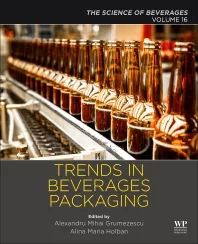Operations
Beverage-makers turning to robotics for operations
Robotics offers ease of operations, support warehouse challenges

Image courtesy of OnRobot
In a 2002 episode of the Nickelodeon animated series “SpongeBob SquarePants,” SpongeBob watches a scary movie about robots. Although he insists he isn’t scared, SpongeBob becomes very paranoid that robots are taking over the world and that they’re everywhere. He goes so far as to accuse his boss, Mr. Krabs, of being a robot.
Although SpongeBob might have been afraid of robots, beverage-makers and wholesalers are turning to robotics to streamline operations.
Mark Koffarnus, major accounts manager at Greenville, N.C.-based Yale Lift Truck Technologies, explains that the advancement of artificial intelligence (AI) capabilities has influenced the robotics market.
Although some businesses view AI and robotics as future propositions, Koffarnus explains that today’s warehouses are becoming more tech-enabled. He notes that operations that are best-in-class expect their material handling equipment to reflect smart automation design and technology integration.
Further, noting that AI is expected to be adopted by 75% of supply chain operations within the next five years, and considers various demands from operations to be a spectrum, Koffarnus points to Yale’s robotic lift trucks as able to perceive and interact with their environment.
Moreover, the trucks can make decisions autonomously by locating themselves in real-time, Koffarnus says. The trucks compare what the navigation laser detects with the reference map, he notes.
“While it’s important to remember that operations have a role to play in supporting the independence of automated solutions, as AI advances, it has the potential to unlock greater capabilities for robotics in relation to exception handling, pallet identification and traffic management efficiencies, allowing them to perform with even fewer interventions,” Koffarnus explains.
James Sharples, vice president of global business acceleration at Swisslog, Newport News, Va., says AI is transforming warehouses to make them “more dynamic, more agile and more responsive.”
He considers it to be “a quantum leap” for process optimization in the way AI networks machine, process and product information.
“For instance, AI enables robotics to self-learn from experience, which means that robotic picking ability improves over time with enhanced picking strategies for new products,” Sharples explains. “Take the Swisslog ItemPiQ as an example. This articulated arm robot is designed for repeated, reliable picking of a wide range of items to fulfill fast delivery of orders at low operating costs.”
Sharples notes that the ItemPiQ’s picking is optimized over time with applied AI. It uses an intelligent 3D vision system that identifies objects in the source bin, while also determining the grasping points of new products using the software algorithm, he says. This allows the robot to continuously learn and eliminates the need for a teaching process for items, which is often time-consuming, he explains.
Kristian Hulgard, general manager for Americas at Dallas-based OnRobot, expresses that, as robots have gotten “smarter,” they’ve become easier to use.
“This is very exciting for OnRobot, because we’re also trying to simplify automation deployments,” he says. “Our D:PLOY software, for example, uses AI to allow users to skip programming completely — slashing deployment times in the process. Instead of reinventing the wheel every time we deploy a robot and spending extreme amounts of time using experts to program robots, D:PLOY can do the programming for you based on a few user inputs.”
The simplification allows OnRobot to fulfill the demands for robots despite personnel limitations.
“We have a rising demand for robots, but we don’t really have enough engineers and technicians to meet this demand,” Hulgard adds. “For end users and integrators alike, this makes minimizing the time it takes to deploy every robot an imperative.”
Robotics market moves ahead
Various technology improvements have aided the advancement of the robotics market.
Yale’s Koffarnus points to emerging technologies in sensors and vision. He says these can help trucks detect obstacles, such as stray boxes in the path of travel, and also validate whether unexpected pallets are in the storage position where the truck is supposed to place one.
“Navigation technology and site-specific programming allow robotic lift trucks to adapt to surroundings and real-time conditions starting on day one, strictly following safety protocols,” Koffarnus explains. “This can help reduce the risk of accidents and collisions, without the extensive onboarding and training required for new operators.”
Swisslog’s Sharples says there have been advances in image processing, sensors and processing power of the machine and edge devices. This progress has enabled an increasing amount of robotic-driven applications, he notes.
For example, Swisslog’s ACPaQ is a robotic and data-driven case palletizer solution for store-ready mixed case palletizing, Sharples notes.
“The highly-flexible solution takes single SKU inbound stock pallets and builds them into mixed SKU outbound order pallets in a desired sequence,” Sharples explains. “ACPaQ is a highly flexible solution, with semi-automated modules available to suit different requirements and align with a business’ growth. Its unique grippers with four forks enables the gentle, simultaneous handling of a wide range of various products.”
OnRobot’s Hulgard suggests that collaborative automation — using collaborative robots and light industrial robots — has shown the industry that there is automation available “that is effective, affordable and easy to use.” He also says that electric tooling has made improvements and found a fit with the rise of cobot and lightweight industrial robot arms.
“Today, a lot of excitement is about software,” Hulgard says. “Instead of end users needing expertise to set up a palletizing application, for example, they can, using software like D:PLOY. Simply plug their electric end effector on to their collaborative robot and be up and running within minutes.”
Hulgard adds that these same applications used to take days to set up and deploy. “The dual rise of collaborative automation and software that reduces deployment time to a fraction are the most significant technological improvements,” he says.
Proliferation presents warehouse challenges
Yale’s Koffarnus notes that beverage operations are seeing between 2-8% more new product introductions than the next leading category.
“With more SKUs to process, store and distribute, it’s crucial for warehouses to maximize their capacity and throughput, and with warehouse rent up 16% this year, looking for additional industrial space to lease or purchase isn’t necessarily the most attractive or cost-effective solution to this SKU challenge,” Koffarnus says. “Beverage warehouses are looking for manufacturers for equipment and slotting strategies that can help them to achieve increased capacity and picking efficiency in their existing space.”
Swisslog’s Sharples also suggests that SKU proliferation is presenting challenges for beverage warehouses. He says companies are combatting this by utilizing mixed-case palletizing.
“It’s all about maximizing the impact of having the goods on the shelf, in-store and available for consumers to purchase,” Sharples explains. “Rather than having to replenish the store in full case quantities, it may be more efficient to replenish the shelves in lower quantities for some products. The goal is to make the case-pick as efficient as possible in the warehouse and then deliver the goods to stores in an easy, efficient way so store employees can process those goods and get them on the shelf as quickly as possible.”
By using automation and robotics, Sharples states that companies can build a delivery pallet where merchandise is sequenced so the goods are in the right place on the pallet.
OnRobot’s Hulgard notes that, in order to automate high mix-low volume SKU handling, robotic systems should be easy to redeploy for product changeovers.
“In contrast to fixed, traditional automation, collaborative automation is highly versatile and can be moved in between applications and new products,” he explains.
Moreover, although traditional, fixed robotic systems are a “great fit for industry giants,” Hulgard points to collaborative automation as a move for small and medium-sized companies with less space in their facilities — or if they have a niche product or high mix/low volume product runs.
OnRobot’s D:PLOY software makes it easy to deploy and redeploy, “which provides flexibility and added value,” Hulgard says.
Yale’s Koffarnus notes that robotic lift trucks give beverage-makers the opportunity to automate multiple workflows in the warehousing process, from receiving loads to picking up loads.
“Robotic lift trucks can help complete these tasks quickly and accurately, and can also provide safety benefits for busy warehouses,” he explains. “Robotic lift trucks, which follow programmed site-specific rules of the road, such as maximum speed or minimum distance from pedestrians, can help reduce incidents attributed to operator error, which make up 70% of lift truck incidents.”
Swisslog’s Sharples suggests that businesses can benefit from implementing pallet automation as a way to support warehouse challenges.
“Pallet automation streamlines the movement and storage of goods in a warehouse, reducing manual labor and increasing efficiency,” he says. “This results in faster order processing, improved inventory management and lower operating costs.”
Such technology also can automatically replenish pallet pick locations, which can save in costs and eliminate the safety risks surrounding manual replenishment, Sharples adds.
“As more businesses adopt mixed-case palletizing in answer to SKU proliferation, pallet automation that enables mixed-cased palletizing is also becoming more important,” he says.
Sharples notes that Swisslog’s ACPaQ, a “highly-flexible solution,” takes single SKU inbound stock pallets and builds them into mixed SKU outbound order pallets in a desired sequence.
“It is scalable for mid-size and large distribution centers, and Swisslog’s SynQ palletizing software allows companies to customize the palletizing order to increase efficiency during in-store replenishment,” he states.
Robotics combat retention challenges
Beverage companies can fight employee retention problems using robotic systems.
Yale’s Koffarnus says that, while robotic lift trucks can seem like they come with a large upfront cost, they can carry great savings “due to lower labor costs, a lower lift truck accident rate and the reallocation of employees to tasks where they are more productive.”
“In today’s high-turnover warehouse, operations commonly depend on less-experienced employees or workers without substantial experience at a specific site,” he states. “Distracted or inexperienced lift truck operators may drive too fast, cut corners too sharply or even drive through prohibited areas, which can lead to mistakes, damage and injuries.”
Koffarnus notes that research shows that operations augmented by automation are 33% more human friendly, and workers are 31% more productive in such environments.
“That’s because robotics can relieve workers of the monotony of repetitive tasks that are abundant in supply chain environments, and allow them to instead focus on more rewarding, higher responsibility work,” he explains. “With warehouse turnover hovering around 40% in recent years, this reallocation of workers to tasks where they feel more valuable to the company can be an important tool to help improve employee satisfaction and promote retention.”
Further, because robotic lift trucks are fully autonomous, a supervisor overseeing activities would only have to intervene in cases such as an object being in the truck’s path of travel, Koffarnus notes.
“In that case, the supervisor can switch the truck from automatic to manual mode with the touch of a button and adapt to these unexpected circumstances by simply engaging the controls to take control just as they would standard lift truck equipment,” he explains. “As with all tools, proper safety training and protocols for all employees are essential to integrating robotic lift trucks into warehouses.”
OnRobot’s Hulgard notes one thing common for today’s customers is the prominence of “We’re hiring” signs.
“This ‘dull, dirty and dangerous’ work is un-ergonomic, and workers are often hard to keep for more than a few months,” he observes. “It’s easier to keep workers if collaborative robots are doing the heavy lifting all day. Plus, the ease of these systems allows workers to quickly upskill from general operative to robot operator.”
Hulgard’s advice to companies is to find the right automation for their respective process and “start reaping the benefits.”
And while it depends on the complexity and size of the company, Hulgard says the learning curve for adding robotics to operation systems is in essence watching 30-60 minutes of videos and reading a manual.
“The emergency of systems like D:PLOY empower end users at SMEs (small and medium-sized companies) to deploy their own robotic applications,” he notes.
After training, users can easily deploy the application themselves without needing to do any programming. This has significantly changed the learning curve in recent years, Hulgard adds.
Swisslog’s Sharples notes that, although there was a stigma surrounding automation in the warehouse, beverage companies have not been immune to labor shortages and employee retention issues.
“They see automation systems as valuable assets to enhance productivity of human workers, create innovative environments that attract skilled labor, and improve workplace safety and ergonomics,” Sharples says.
Noting that automation best practices often “focus on the design and configuration of the system,” as well as the implementation and the operational side, Sharples says that, “most of these best practices come from early automation adopters and can help guide other companies as they determine their automation strategy and deploy automation solutions.”
Sidebar: What’s unfolding for robotics
On the horizon for robotic systems, Mark Koffarnus, major accounts manager at Greenville, N.C.-based Yale Lift Truck Technologies says the company’s focus on research, development and technology integration has a history of bringing technology to market quickly — including hundreds of robotic lift trucks.
“Because we provide a mature, commercially proven lineup, our robotic lift trucks benefit from experience in a wide-range of real-world applications and continuous improvement,” he says.
However, Koffarnus notes that the challenge for warehouses is integrating technology, and truck and technology must work together with various requirements.
“While implementing robotics in your warehouse does not have to require massive infrastructure shifts, optimizing workflows and the facility for automation is an important step, and those recommendations are part of the full solution from our team of experts,” Koffarnus explains.
James Sharples, vice president of global business acceleration at Swisslog, Newport News, Va., suspects that connected and intelligent systems will continue to advance.
“As solutions become more standardized, it becomes easier to leverage data (e.g., edge data, sensor data, product data, operational data) to make more insightful and effective operational decisions,” he says. “This standardization is especially important for AI-enabled solutions. Maturity solution design and software platforms will enable companies to leverage these technologies and the information that are more widely in use outside of our industry.”
Sharples also expects further production of software platforms from integrators.
“This will bring a level of standardization to software that will be more beneficial than customized software, especially in the long term,” he explains. “This will include increased flexibility and configurability, as well as a framework for continued evolution of robotic systems. The risks that come with the larger, more complex integrated systems require more collaboration with customers on reducing risk through more standardized, productized solutions.”
As for general trends, Kristian Hulgard, general manager for Americas at Dallas-based OnRobot, expects automation suppliers to make it easier to use and to bridge the gap between manufacturing companies and integrators.
“I think the future holds more platforms that offer easier integration and easier deployment,” he concludes.
Looking for a reprint of this article?
From high-res PDFs to custom plaques, order your copy today!









